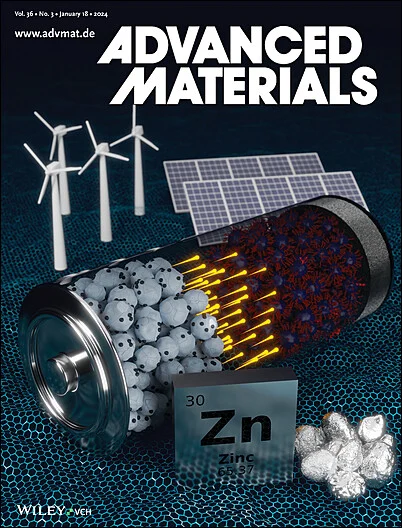宽禁带钙钛矿太阳能电池的研究进展
IF 26.8
1区 材料科学
Q1 CHEMISTRY, MULTIDISCIPLINARY
引用次数: 0
摘要
宽带隙(WBG)钙钛矿太阳能电池(PSCs)最近因其作为建筑集成的半透明光伏电池、串联配置的顶部电池和物联网(IoT)应用的室内光伏电池(IPVs)的潜力而引起了相当大的关注。然而,最近的研究表明,潜在的缺陷介导的相偏析、离子迁移、晶格应变和其他因素可以引起自加速降解反应和器件内准费米能级分裂(QFLS)的收缩。广泛的努力已经进行,以减少缺陷密度在块状,表面和跨界面与电荷传输层(ctl)。这篇综述提供了对WBG钙钛矿固有缺陷生态系统的及时和全面的了解,并从机制上阐明了它们对器件稳定性和开路电压损失的影响。随后,对缺陷钝化策略的最新进展进行了横断面概述,涵盖了器件的各种组件。讨论了WBG PSCs在半透明器件、串联应用和IPVs中的应用。最后,提出了展望和挑战,为未来的研究和技术进步提供了见解。本文章由计算机程序翻译,如有差异,请以英文原文为准。

Recent Advances in Wide-Bandgap Perovskite Solar Cells
Wide-bandgap (WBG) perovskite solar cells (PSCs) have garnered considerable attention of late for their potential as semitransparent photovoltaics for building integration, top-cells in tandem configurations, and indoor photovoltaics (IPVs) for Internet of Things (IoT) applications. However, recent investigations have unveiled that underlying defect-mediated phase segregation, ion migration, lattice strain, and other factors can give rise to self-accelerated degradation reactions and the contraction of quasi-Fermi level splitting (QFLS) within devices. Extensive efforts have been undertaken to reduce defect densities in bulks, at surfaces, and across interfaces with charge transport layers (CTLs). This review provides a timely and comprehensive understanding of the intrinsic defect ecosystem in WBG perovskites, and mechanistically elucidates their impacts on device stability and open circuit voltage losses. Subsequently, recent advances in defect passivation strategies are cross-sectionally overviewed, covering various components of devices. The applications of WBG PSCs in semitransparent devices, tandem applications, and IPVs are discussed. Finally, prospects and challenges are proposed, providing insights for future research and technological advancements.
求助全文
通过发布文献求助,成功后即可免费获取论文全文。
去求助
来源期刊

Advanced Materials
工程技术-材料科学:综合
CiteScore
43.00
自引率
4.10%
发文量
2182
审稿时长
2 months
期刊介绍:
Advanced Materials, one of the world's most prestigious journals and the foundation of the Advanced portfolio, is the home of choice for best-in-class materials science for more than 30 years. Following this fast-growing and interdisciplinary field, we are considering and publishing the most important discoveries on any and all materials from materials scientists, chemists, physicists, engineers as well as health and life scientists and bringing you the latest results and trends in modern materials-related research every week.
 求助内容:
求助内容: 应助结果提醒方式:
应助结果提醒方式:


